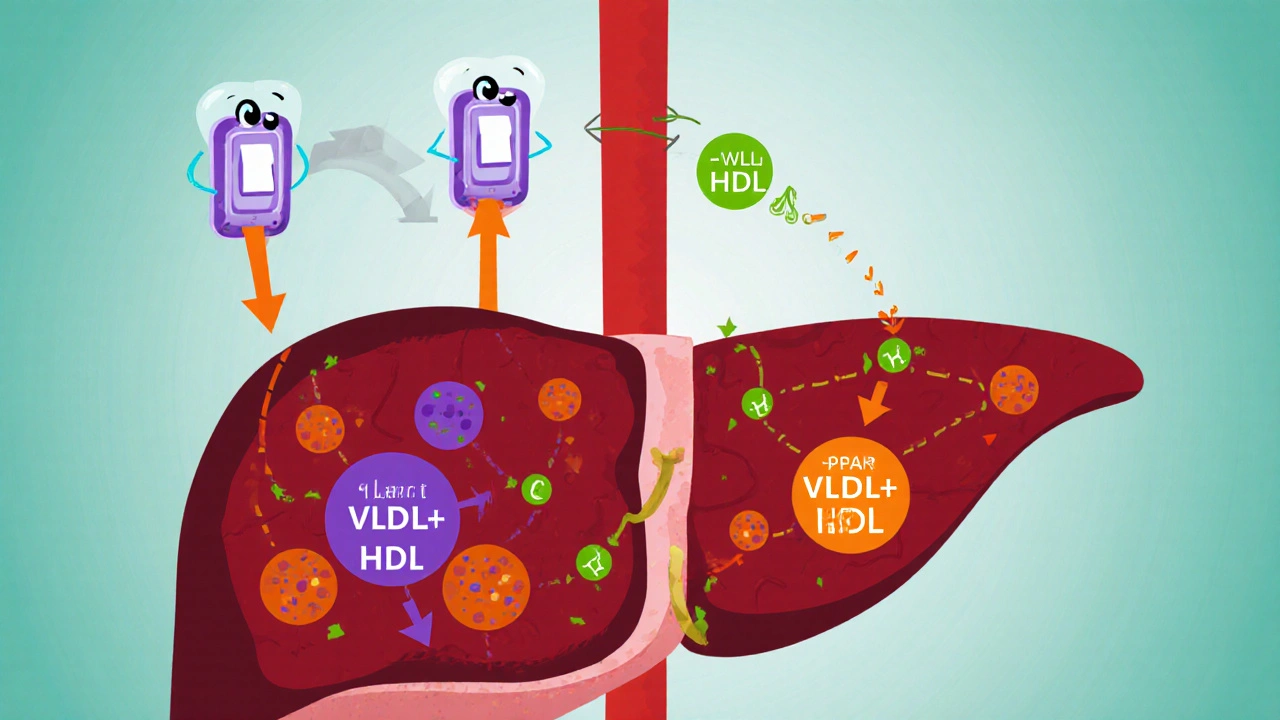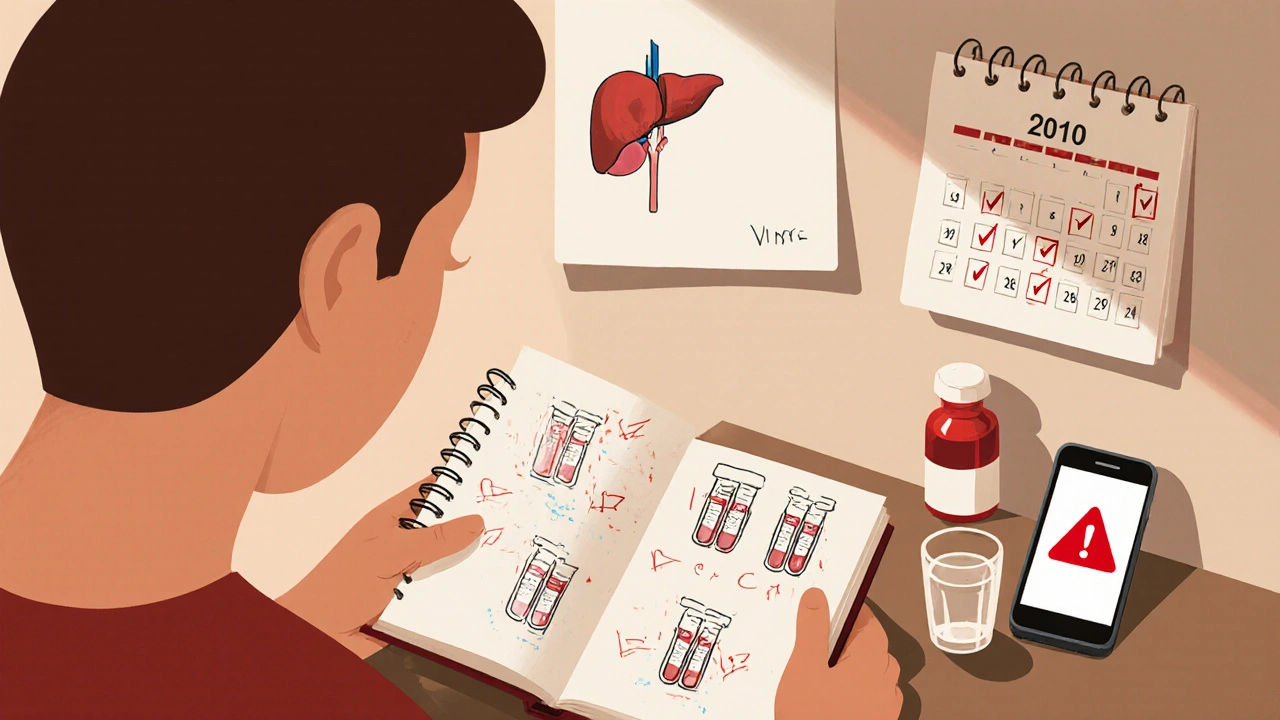Fenofibrate Monitoring Schedule Calculator
Track Your Fenofibrate Monitoring Schedule
Enter your start date for fenofibrate and get a personalized schedule for your blood tests.
When you’re prescribed Fenofibrate is a lipid‑lowering medication used to reduce triglycerides and raise HDL cholesterol, the pill itself is only half the story. Your doctor will likely ask you to come back for a series of blood tests to make sure the drug is doing its job without hurting your liver, kidneys, or muscles. That’s why Fenofibrate blood tests are a non‑negotiable part of safe therapy.
What is Fenofibrate?
Fenofibrate belongs to the fibrate class of drugs. It activates a protein called PPAR‑α, which tells the liver to break down triglyceride‑rich particles and to produce more HDL (the “good” cholesterol). In the UK, fenofibrate is commonly sold under brand names like Tricor, Lipofen, and Lofibra.
The typical adult dose ranges from 145 mg to 160 mg once daily, taken with meals to improve absorption. Most people notice a drop in fasting triglycerides within 4-6 weeks, and a modest rise in HDL after a few months.
How Fenofibrate Works - A Quick Overview
Once inside the liver, fenofibrate binds to the peroxisome proliferator‑activated receptor‑alpha (PPAR‑α). This triggers a cascade of genetic changes:
- Increased production of lipoprotein lipase, which clears triglyceride‑rich VLDL from the bloodstream.
- Reduced synthesis of apolipoprotein C‑III, a protein that slows VLDL breakdown.
- Enhanced expression of enzymes that convert VLDL into LDL, but the resulting LDL particles are often larger and less atherogenic.
Why Regular Blood Tests Are Essential
Fenofibrate is generally well tolerated, but it can stir up the body’s chemistry in ways that aren’t obvious without a lab draw. The most common safety concerns involve the liver, kidneys, and muscle tissue. Monitoring these organs helps you and your clinician catch problems early, adjust the dose, or switch to an alternative if needed.
Skipping a scheduled test can mean missing a silent rise in liver enzymes or a subtle decline in kidney function-both of which can become serious if left unchecked.

Key Lab Tests to Order While on Fenofibrate
Below is a short cheat‑sheet of the most informative tests. Each test has a clear purpose and a typical target range.
- Lipid panel - Measures triglycerides, HDL, LDL, and total cholesterol. It tells you whether fenofibrate is hitting its primary goal.
- Liver function test - Usually includes ALT, AST, and alkaline phosphatase. Elevations >3 × upper limit of normal warrant a pause or dose reduction.
- Kidney function test - Serum creatinine and estimated GFR (eGFR). Fenofibrate is cleared by the kidneys, so a drop in eGFR below 60 ml/min/1.73 m² may need dose adjustment.
- Creatine kinase (CK) test - Screens for muscle injury. If CK rises above 5 × normal, stop the drug and evaluate for myopathy.
- Fasting glucose or HbA1c - Fenofibrate can modestly raise blood sugar in people with diabetes; monitoring helps fine‑tune diabetic meds.
- Complete blood count (CBC) - Rarely affected, but useful if you develop unexplained fatigue or bruising.
Recommended Monitoring Schedule
| Test | Baseline (before starting) | 4-12 weeks | Every 6-12 months |
|---|---|---|---|
| Lipid panel | ✓ | ✓ (assess response) | ✓ (maintain goal) |
| Liver function test | ✓ | ✓ (catch early rise) | ✓ (long‑term safety) |
| Kidney function test | ✓ | ✓ (especially if elderly) | ✓ (track trends) |
| Creatine kinase | Optional | ✓ if muscle pain occurs | ✓ if prior elevation |
| Fasting glucose / HbA1c | ✓ if diabetic | ✓ (review) | ✓ (routine) |
The schedule is a guideline, not a rule. Your doctor may order additional checks based on your personal health history, other medications, or any symptoms that pop up.
Interpreting Results - When to Adjust or Stop
Here’s a quick decision tree you can run through after each lab visit:
- If triglycerides have dropped by at least 30 % and HDL is up, the drug is effective.
- If ALT or AST rise above 3 × ULN, pause the medication and repeat the test in 2 weeks. Persistent elevation usually leads to discontinuation.
- If eGFR declines by more than 10 % from baseline, consider cutting the dose in half or switching to a lower‑dose formulation.
- If CK is above 5 × normal, stop fenofibrate immediately and assess for muscle pain, recent exercise, or drug interactions (e.g., statins).
- If fasting glucose climbs more than 15 mg/dL, discuss with your diabetes team; you may need an extra oral hypoglycemic.
Always bring the lab report to your appointment. Clear numbers give your clinician the confidence to keep you on the right track.

Common Pitfalls and Patient Tips
- Skipping meals. Fenofibrate’s absorption spikes with food. Taking it on an empty stomach can lower its effectiveness.
- Ignoring mild muscle soreness. A dull ache can be the first sign of CK elevation. Report it early.
- Not updating your GP about new meds. Some antibiotics, antifungals, and even over‑the‑counter NSAIDs raise the risk of liver injury when combined with fenofibrate.
- Assuming “normal” cholesterol means you’re fine. Triglycerides can be high even when LDL looks good; the lipid panel captures the full picture.
- Waiting too long for follow‑up. The 4‑week window is critical for spotting early liver or kidney signals.
Keep a small notebook or a notes app with the date of each blood draw, the lab values, and any symptoms you felt. This log makes the next appointment smoother.
When to Talk to Your Doctor Immediately
If you notice any of the following, call your GP or go to urgent care:
- Severe abdominal pain or yellowing of the skin/eyes (possible liver trouble).
- Unexplained swelling of the legs or sudden weight gain (kidney fluid retention).
- Intense muscle pain, especially if it’s new or after heavy exercise (risk of rhabdomyolysis).
- Persistent nausea, vomiting, or loss of appetite lasting more than a few days.
Prompt action can prevent a mild lab abnormality from becoming a serious medical issue.
Frequently Asked Questions
How often should I get a lipid panel while on fenofibrate?
A baseline test is required before starting. Then repeat at 4-12 weeks to see the drug’s effect, and at least once a year to keep the numbers in check.
Can fenofibrate cause liver damage?
It’s rare, but elevations in ALT or AST can occur. Monitoring every 4-12 weeks after you start the medication helps catch any rise early.
Do I need a kidney test even if I have normal kidney function?
Yes. Fenofibrate is cleared by the kidneys, so a baseline eGFR and periodic re‑checks ensure the drug isn’t building up to harmful levels.
What should I do if my CK level is high?
Stop fenofibrate immediately, avoid strenuous exercise, and let your doctor re‑check CK in a few days. They may switch you to a different lipid‑lowering strategy.
Can fenofibrate be taken with statins?
Many clinicians prescribe both, but the combo raises the risk of muscle injury. If you’re on a statin, your doctor will likely check CK more frequently.

Norman Adams
October 18, 2025 AT 14:32Oh great, another reminder to bleed money for blood draws.
Margaret pope
October 21, 2025 AT 10:02Keeping up with the labs actually saves you from bigger problems later. A simple schedule on your phone can remind you when it’s time. Talk to your pharmacist about setting up automatic reminders. It’s not worth the hassle of an unexpected liver issue.
Linda A
October 24, 2025 AT 05:32In the quiet rhythm of blood, we find the truth of our bodies; the labs are the verses we often ignore.
Stephanie Zaragoza
October 27, 2025 AT 01:02Regular monitoring of liver enzymes, such as ALT and AST, provides a clear window into hepatic health, and any deviation should never be dismissed lightly. The kidneys, evaluated by serum creatinine and eGFR, act as the body's filtration system, and their function can wane subtly under the influence of fenofibrate. Muscle integrity, reflected by CK levels, may betray early signs of myopathy, especially when combined with statins, and early detection prevents catastrophic rhabdomyolysis. Triglyceride reduction, while the primary goal, must be weighed against potential metabolic shifts, such as modest increases in fasting glucose, which can exacerbate pre‑existing diabetes. A baseline lipid panel, taken before therapy commences, establishes a reference point, allowing clinicians to quantify the drug's efficacy with precision. Subsequent panels at 4 to 12 weeks, and then semi‑annually, chart the trajectory of triglycerides, HDL, and LDL, offering insight into whether therapeutic targets are met. Should ALT rise above three times the upper limit of normal, it is prudent to pause the medication, repeat the test in a fortnight, and consider alternative lipid‑lowering strategies. If eGFR declines more than ten percent from baseline, dosage reduction, or a switch to a kidney‑friendly formulation, becomes necessary to avoid drug accumulation. Elevated CK, defined as five times the upper limit, mandates immediate cessation of fenofibrate, cessation of strenuous exercise, and a thorough evaluation for other contributing agents. Patients with concomitant liver disease, severe renal impairment, or a history of muscle disorders should undergo more frequent monitoring, reflecting their heightened risk profile. The interplay between fenofibrate and other medications, such as certain antibiotics, antifungals, or NSAIDs, underscores the importance of a comprehensive medication review at each visit. Lifestyle factors, including alcohol consumption, high‑protein diets, and vigorous workouts, can modulate lab results, and clinicians should counsel patients accordingly. Maintaining a personal log of blood draw dates, values, and any symptoms creates a valuable narrative that streamlines clinical discussions. In practice, many clinicians employ electronic health record alerts to flag abnormal results, ensuring timely intervention. Ultimately, the synergy of patient vigilance, scheduled labs, and clinician expertise cultivates a safe and effective fenofibrate therapy.
Janet Morales
October 29, 2025 AT 20:32Who needs all these labs anyway? I’m fine, I feel great, and I’m not going to let a piece of paper tell me otherwise.
Tracy O'Keeffe
November 1, 2025 AT 16:02Honestly the whole fenofibrate surveillance is just pharma’s way of keeping us chained to the lab‑rat race, w/ their fancy “PPAR‑α” hype and all. Still, if you’re into that bio‑buzz, make sure you schedule your draws before the next moon cycle, otherwise the “results” *might* be cursed.
Rajesh Singh
November 4, 2025 AT 11:32While it’s tempting to view monitoring as a corporate trap, the ethical responsibility we have to our own bodies outweighs any conspiratorial narratives. Ignoring liver or kidney signals isn’t just reckless-it’s a betrayal of the trust our physicians place in us.
Albert Fernàndez Chacón
November 7, 2025 AT 07:02Just keep a reminder on your phone, bring the report to your next appointment, and let your doctor guide any changes. Simple steps keep things safe.
Matthew Miller
November 10, 2025 AT 02:32Exactly! Think of each blood draw as a power‑up for your health-check that level‑up bar and keep crushing those triglycerides!
Liberty Moneybomb
November 12, 2025 AT 22:02Don't you ever wonder why the labs always come back “normal” right before the next prescription? It's like the system is designed to keep us complacent while the real damage happens behind the scenes.
Alex Lineses
November 15, 2025 AT 17:32Focus on the practical side: follow the schedule, log your values, and discuss any odd patterns with your clinician. Consistency beats paranoia every time.
Brian Van Horne
November 18, 2025 AT 13:02In summation, adherence to the recommended monitoring regimen ensures therapeutic efficacy while safeguarding hepatic, renal, and muscular integrity.